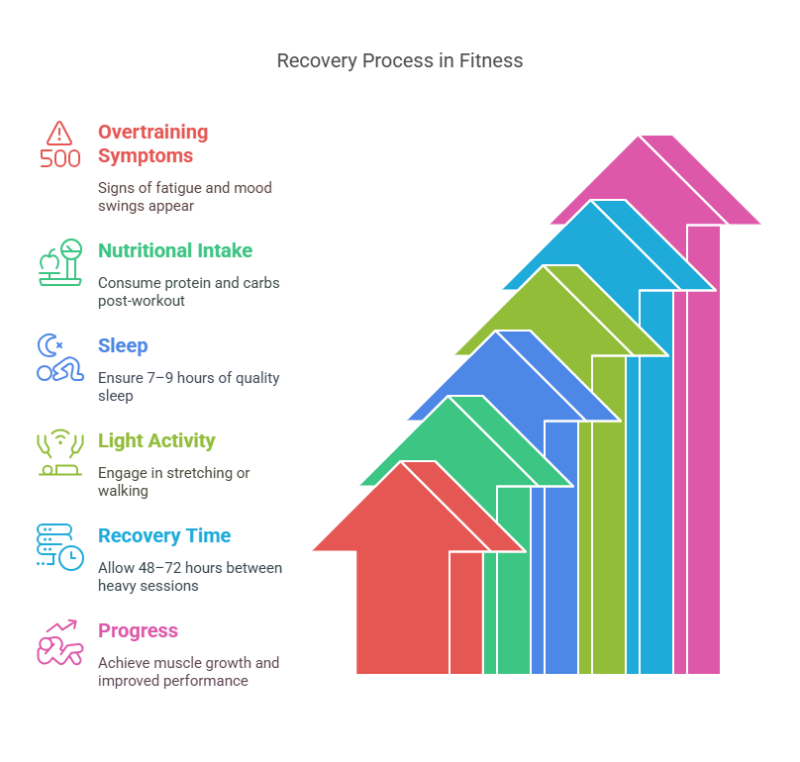After
a
grueling
workout—legs
quaking,
arms
burning—you’re
left
wondering
what’s
happening
inside
as
you
hit
the
couch.
I’ve
coached
fitness
for
over
ten
years,
and
that
post-exercise
storm
in
your
body
is
intense.
Muscle
recovery
isn’t
just
chugging
a
protein
shake;
it’s
a
repair
process
that
can
make
you
stronger—if
you
nail
it.
I’ve
watched
clients
thrive
or
tank
because
they
missed
how
it
works
under
the
skin.
Here’s
the
deal:
post-workout,
your
muscles
are
intentionally
damaged,
triggering
a
repair
chain
that
can
build
you
up
or
break
you
down.
I’ll
unpack
the
anatomy,
drop
a
few
studies,
and
share
pro
tips
that
deliver.
The
Wrecking
Crew:
What
You
Do
to
Your
Muscles

Picture
your
muscles
as
a
construction
site
mid-demolition.
When
you
lift,
run,
or
squat,
you’re
tearing
tiny
holes
in
the
muscle
fibers—microtears,
we
call
them.
It’s
not
a
bad
thing;
it’s
the
spark
that
gets
the
gains
rolling.
Take
a
deadlift:
your
hamstrings
and
glutes
contract
hard,
and
those
fibers
stretch
and
snap
under
the
load.
A
2012
study
in
the
Research
Gate
showed
that
eccentric
moves—like
lowering
that
barbell—do
the
most
damage,
ripping
apart
the
sarcomeres
(the
muscle’s
building
blocks)
in
a
way
that
screams
for
repair.
But
here’s
the
kicker:
that
soreness
you
feel?
It’s
not
just
the
tears.
Your
body
floods
the
area
with
inflammation—think
of
it
as
the
cleanup
crew
rushing
in
hot.
Blood
flow
ramps
up,
bringing
oxygen
and
nutrients,
while
immune
cells
swoop
in
to
clear
the
debris.
It’s
a
messy,
brilliant
process,
and
it’s
why
you’re
stiff
as
a
board
the
next
day.
DOMS:
The
Ache
You
Love
to
Hate
Let’s
talk
Delayed
Onset
Muscle
Soreness
(DOMS)
because
I
know
you’ve
cursed
it
after
leg
day.
DOMS
hits
24–48
hours
post-workout,
and
it’s
your
muscles
yelling,
“Hey,
we’re
rebuilding
here!”
It’s
tied
to
that
inflammation
and
the
repair
of
those
microtears.
I’ve
had
clients
swear
they’re
broken,
but
it’s
just
the
body
doing
its
job.
A
2017
study
in
NCBI
pinned
DOMS
to
the
combo
of
muscle
damage
and
the
inflammatory
response—nothing
dangerous,
just
your
system
signaling
it’s
time
to
adapt.
Stretch
too
hard
or
skip
recovery,
though,
and
you’ll
feel
it
longer.
Stats
That
Matter
To
give
you
a
clearer
picture,
I’ve
pulled
some
hard
facts
from
the
trenches
of
muscle
recovery
science.
Check
out
this
table—real
data,
no
fluff:
| Factor | Impact | Stat |
|
Muscle Damage Peak |
When microtears hit the hardest |
6–12 hours post-exercise |
|
Satellite Cell Activation |
Time to kickstart repair |
Peaks at 24 hours, lasts up to 72 |
|
Protein Synthesis Boost |
How much it ramps up |
Up to 50% increase within 2 hours post-workout |
|
DOMS Duration |
How long you’ll feel it |
24–72 hours, depending on intensity |
What
does
this
mean
for
you?
That
6-12
hour
window
after
your
workout
is
when
your
muscles
are
crying
for
help—
inflammation’s
peaking
and
damage
is
fresh.
By
24
hours,
those
satellite
cells
are
on
the
job,
and
if
you’ve
got
protein
in
your
system,
synthesis
can
jump
50%.
DI’s
OMS
sticking
around
for
three
days?
I’ve
been
telling
some
of
my
crew
to
try
red
light
therapy
after
workout
to
speed
up
that
inflammation
cooldown—it’s
been
a
game-changer
for
a
few,
cutting
soreness
and
getting
them
back
in
the
gym
faster.
The
Repair
Shop:
How
Muscles
Bounce
Back

Once
the
wrecking’s
done,
the
repair
crew
clocks
in.
Your
body
flips
a
switch,
sending
satellite
cells—muscle
stem
cells—into
overdrive.
These
little
heroes
fuse
to
the
damaged
fibers,
patching
them
up
and
making
them
thicker
and
stronger.
It’s
called
hypertrophy,
and
it’s
why
you
can
hoist
more
weight
next
month
than
you
did
today.
A
study
from
PubMed
tracked
this
in
action:
after
resistance
training,
satellite
cell
activity
spiked
within
24
hours,
laying
the
groundwork
for
bigger
biceps
or
quads.
Protein
synthesis
kicks
into
high
gear
too.
Your
muscles
guzzle
amino
acids
from
your
diet—chicken,
whey,
whatever—to
rebuild
the
torn
spots.
Timing
matters
here.
Slam
a
protein
shake
within
an
hour
post-workout,
and
you’re
feeding
that
repair
window
when
it’s
wide
open.
Miss
it,
and
you’re
still
rebuilding,
just
slower.
Fueling
the
Fire:
Blood
and
Hormones

After
a
session,
your
vessels
dilate,
rushing
nutrients
like
glucose
and
oxygen
to
the
site.
Blood
flow’s
your
unsung
hero
in
all
this.
Ever
noticed
that
post-gym
pump?
That’s
your
muscles
swollen
with
blood,
and
it’s
not
just
for
looks—it’s
feeding
the
recovery
beast.
Hormones
jump
in,
too.
Testosterone
and
growth
hormone
spike,
especially
after
heavy
lifts,
acting
like
foremen
barking
orders
to
build
muscle
back
better.
A
2020
study
in
Medicine
&
Science
in
Sports
&
Exercise
found
that
these
hormonal
surges
peak
right
after
training,
then
taper
off—another
reason
to
rest
smart.
The
Rest
Factor:
Why
You
Can’t
Skip
It
Here’s
where
I
get
stern
with
my
clients:
recovery
isn’t
optional.
Push
too
hard
without
rest,
and
you’re
not
a
warrior—you’re
a
fool,
breaking
yourself
down.
Sleep’s
the
kingpin
here.
When
you’re
out
cold,
your
body
ramps
up
protein
synthesis
and
hormone
release.
Skimp
on
it,
and
you’re
stalling
the
rebuild.
I’ve
seen
guys
hit
the
gym
daily,
with
no
breaks,
and
plateau
hard
because
their
muscles
never
got
the
memo
to
grow.
Active
recovery’s
clutch
too—think
light
walks
or
yoga.
It
keeps
blood
moving
without
taxing
the
fibers
more.
Overdo
it,
though,
and
you’re
back
to
square
one.
Balance
is
everything.
What
Can
Go
Wrong?
Ignore
recovery,
and
you’re
flirting
with
trouble.
Overtraining
syndrome’s
real—fatigue,
mood
swings,
stalled
gains—and
it’s
your
body
waving
a
red
flag.
I’ve
coached
people
who’ve
hit
this
wall,
and
it’s
brutal
to
claw
back
from.
Even
minor
slip-ups,
like
dehydration
or
skipping
carbs,
slow
the
process.
Your
muscles
need
water
and
glycogen
to
rebuild;
starve
them,
and
they’ll
sulk.
Making
It
Work
for
You

what
vibes
with
you.
Back
to
that
shaky-leg
moment
after
your
workout:
it’s
the
start
of
something
epic.
So,
how
do
you
nail
recovery?
I
tell
my
crew:
eat,
sleep,
move
smart.
Get
20–30
grams
of
protein
post-workout—think
eggs
or
a
shake.
Pair
it
with
carbs
like
rice
or
a
banana
to
restock
glycogen.
Sleep
7–9
hours,
no
excuses.
And
don’t
just
sit
there—light
stretching
or
a
walk
the
next
day
keeps
things
humming.
Ice
baths
or
foam
rolling?
They
feel
good,
but
the
science
is
shaky
on
if
they
speed
things
up.
Your
body’s
tearing
down
to
build
up,
turning
microtears
into
muscle
that
can
handle
more
next
time.
It’s
not
instant—give
it
48–72
hours
between
heavy
sessions—but
it’s
worth
it.
Recovery
is
where
the
magic
lives,
sculpting
you
into
the
powerhouse
you’re
chasing.
So,
next
time
you’re
sore,
grin
through
it.
That
ache?
It’s
progress
knocking.
How
do
you
bounce
back—got
a
go-to
trick?